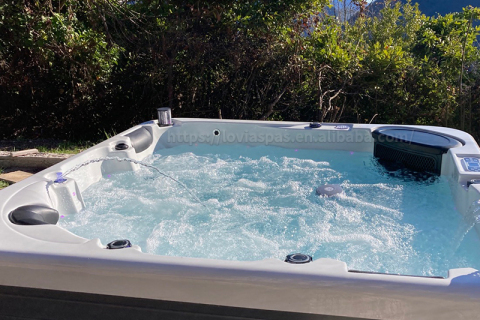
- Home
- >
News
The maximum water temperature of modern hot tubs is usually set at 104°F (40°C), which is the internationally recognized safety upper limit. Most hot tub temperature control systems will force the water temperature to not exceed this standard.
Advantages of long-term opening ● Maintaining massage effect: Turning on the relaxation nozzle for a long time can maintain continuous water flow massage, help relieve muscle tension, and bring a deeper relaxation effect. ● Good water circulation effect: The long-term opening of the nozzle helps the water body circulate, which can prevent the water quality from becoming turbid, and at the same time allow the disinfectant to be fully distributed in the water.
we can roughly determine the nozzle configuration plan for a 4-person outdoor hot tub. For an ordinary 4-person bathtub, it is usually necessary to configure 12 to 20 massage nozzles.
For a 10-jet system, the total impact force is 7.56 Newtons. This is the total pressure exerted by the water flow on the surface of the human body. Although this number may seem small, in actual use, it will be significantly amplified due to the distribution of the water flow and the different contact areas of the human body, producing a massage effect.
When the pH level in a hot tub is too low, the water becomes acidic, which can have significant effects on the skin. Acidic water weakens the natural barrier on the surface of the skin, making the skin more vulnerable to chemicals and bacteria, which can cause problems such as rashes.
Hot tubs are typically set at a maximum temperature of 104 degrees Fahrenheit, which is the upper safety limit set by the U.S. Consumer Product Safety Commission (CPSC) and many hot tub manufacturers.
Advantages of bromine: Stable under high temperature conditions Less irritating Continuous sterilization ability Bromine has certain disinfection ability Not susceptible to pH fluctuations Disadvantages of Bromine: Higher cost Not as oxidizing as chlorine Bromine accumulation problem Requires regular maintenance and replenishment Compatibility with devices
In theory, a forklift can indeed lift a hot tub. After all, forklifts are originally designed to move heavy and bulky objects. Most hot tubs weigh between 300 and 900 kilograms, depending on their size, materials and design, and the maximum weight capacity of a forklift is usually in excess of this range, so from a load-bearing capacity perspective, a forklift is capable of handling this type of task.
Chlorine is a very common disinfectant and is widely used in the water quality maintenance of swimming pools and hot tubs. Chlorine kills bacteria, viruses and other harmful microorganisms in water by releasing hypochlorous acid. The strong oxidizing property of hypochlorous acid can effectively destroy the cell wall of bacteria and the protein structure in the cell, thereby quickly killing bacteria.
There may be many reasons why a hot tub cannot heat up, such as: 1. Heater failure 2. Power problem 3. Thermostat failure 4. Pump failure 5. Filter blockage 6. Low water level 7. Heater overheat protection mechanism activated 8. Inadequate energy supply
Build a physical barrier around the hot tub, such as a fence, windshield or plant barrier, which can effectively reduce the direct impact of strong winds on the tub, thereby reducing heat loss. Especially when used in cold areas or in winter, the windshield design around the tub can significantly improve the insulation effect of the tub.
A hot tub's circulation system typically relies on a pump to keep the water moving, and if the water stops flowing, especially in cold temperatures, the still water will quickly freeze. Frozen pipes can cause pipe ruptures or pump damage, or in severe cases, even paralyze the entire system.












